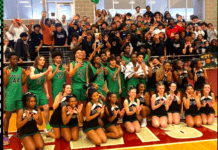Across the nation, early voter turnout is hitting record numbers. It has some wondering if this election could have the highest turnout in over 100 years.
According to one news report, 38% of Americans or 58.8 million have already voted with nine days to go. This represents 42% of the total of all votes cast in the last presidential election in 2016. Texas is reporting huge numbers with 7,173,088 voting or 42.31%. Tarrant County is reporting that approximately 39% of eligible voters have already voted. Precinct 2171 in Kennedale has reported a 41% turnout so far.
Will this result in fewer votes being cast on Election Day, November 3, 2020? It is anyone’s guess.
Outside of all the hype, what is a historical number, percentage-wise, for eligible voters nationwide in a presidential election year? (Disclaimer, information in this article is from Wikipedia, an open-source online encyclopedia).
1800’s turnout hit 80% three times …
First, let us mention that records were not available prior to 1828. Second, the pool of eligible voters was much less then than now – white men 21 years of age (Note: Most states had dropped property ownership requirements by then. North Carolina held out until 1856, although being a taxpayer was a requirement that remained in several states.)
- 1840 set the bar for high voter turnout with 80.2% of eligible voters in the then United States with 26 states. This was the election that William Henry Harrison (Whig) defeated incumbent President Martin Van Buren. Harrison at 67 was at that time the oldest elected president, a record held until Ronald Regan won in 1980. Harrison died a month later. A downturn in economic conditions was a major issue in this election.
- The 1860 election saw the 1840 record broken when 81.2% of the voters came to the polls. Slavery and states’ rights drove interest in that election. Abraham Lincoln won in a divided contest that had four different candidates running for the office. Each of the four won more than 10% of the vote, but no one won an absolute majority. Lincoln (Republican) walked away with a plurality of 39.8% followed by Senator Stephen A. Douglas (Democratic) 29.5%, Vice President John C. Breckinridge (Southern Democratic) 18.1%, and Senator John Bell (Constitutional Union)12.6%.
- 1876 saw the 1860 record exceeded when 81.8% of the electorate turned out to vote when Rutherford B. Hayes Rutherford Hayes (Republican) defeated Samuel J. Tilden (Democratic). This election remains one of the most controversial in the United States’ history. Tilden won the popular vote 50.9% to 47.9% but the electoral college vote was in dispute in Florida, Louisiana, South Carolina and Oregon. These states accounted for 20 electoral votes. Tilden had won outright a total of 184 votes and Rutherford had 165. Rutherford would have to have all 20 votes in the contested states to win. In what has been referred to as a “backroom deal” between the two major parties, Rutherford got his 20 votes and the southern Democrats got the removal of all federal troops stationed in the old Confederacy since the Civil War ended.
1900 hit over 70% but that would be the last time …
It is somewhat vexing that in the world’s largest and first democracy in modern times, that more than a third of eligible voters don’t vote, and on more than one occasion that reaches almost half. (It needs to been noted that near-universal suffrage was reached during the 1900s when females got the right to vote in 1920, the poll tax was ruled illegal and the 1965 voting rights act guaranteed minorities equal right to vote).
- Overall, the voting percentage of eligible voters remain high throughout the 1800s but the 1900 presidential elections would be the last time the America percentage would hit over 70%. In that election, President William McKinley (Republican) with New York Governor Theodore Roosevelt as his running mate won his second term in office over William Jennings Bryan (Democratic). It had a 73.7% voter turnout.
- 1908 marked the highest turnout at 65.4% since 1900. It is a record that has not been bested in 111 years. This year’s early turnout has some predicting that it will reach and even exceed the 1908 turnout. In that election, William Howard Taft defeated William Jennings Bryan (Democratic) with 65.4% of eligible voters casting their vote.
- The lowest since 1908 was in 1996 win President Bill Clinton (Democratic) defeated former Senate Majority Leader Bob Dole (Republican) and H Ross Perot (Reform Party) and only 49% of voters cast their vote.
- Two presidential elections in recent history had barely 50%. In 1988 when Vice President George H. W. Bush (Republican) defeated Massachusetts Governor Michael Dukakis (Democratic) and 2000 when Texas Governor George W. Bush (Republican) defeated Vice President Al Gore (Democratic) recorded just 50.3% each. The Bush/Gore contest became known by the phrase “hanging chad” and eventually took the Supreme Court ruling to force a final decision.
- In 2016, businessman Donald Trump (Republican) defeated former secretary of state Hillary Clinton (Democratic) in an election that had a 55.5% turnout.
The following is a chart from Wikipedia that is interactive by clicking on any date will link to info about that presidential election.
Turnout statistics
| Election | Voting Age Population (VAP)[20] | Turnout[20] | % Turnout of VAP[20][21] |
|---|---|---|---|
| 1789–1824 | No data | ||
| 1828 | 57.6% | ||
| 1832 | 55.4% | ||
| 1836 | 57.8% | ||
| 1840 | 80.2% | ||
| 1844 | 78.9% | ||
| 1848 | 72.7% | ||
| 1852 | 69.6% | ||
| 1856 | 78.9% | ||
| 1860 | 81.2% | ||
| 1864 | 73.8% | ||
| 1868 | 78.1% | ||
| 1872 | 71.3% | ||
| 1876 | 81.8% | ||
| 1880 | 79.4% | ||
| 1884 | 77.5% | ||
| 1888 | 79.3% | ||
| 1892 | 74.7% | ||
| 1896 | 79.3% | ||
| 1900 | 73.2% | ||
| 1904 | 65.2% | ||
| 1908 | 65.4% | ||
| 1912 | 58.8% | ||
| 1916 | 61.6% | ||
| 1920 | 49.2% | ||
| 1924 | 48.9% | ||
| 1928 | 56.9% | ||
| 1932 | 75,768,000 | 39,817,000 | 52.6% |
| 1936 | 80,174,000 | 45,647,000 | 56.9% |
| 1940 | 84,728,000 | 49,815,000 | 58.8% |
| 1944 | 85,654,000 | 48,026,000 | 56.1% |
| 1948 | 95,573,000 | 48,834,000 | 51.1% |
| 1952 | 99,929,000 | 61,552,000 | 61.6% |
| 1956 | 104,515,000 | 62,027,000 | 59.3% |
| 1960 | 109,672,000 | 68,836,000 | 62.8% |
| 1964 | 114,090,000 | 70,098,000 | 61.4% |
| 1968 | 120,285,000 | 73,027,000 | 60.7% |
| 1972 | 140,777,000 | 77,625,000 | 55.1% |
| 1976 | 152,308,000 | 81,603,000 | 53.6% |
| 1980 | 163,945,000 | 86,497,000 | 52.8% |
| 1984 | 173,995,000 | 92,655,000 | 53.3% |
| 1988 | 181,956,000 | 91,587,000 | 50.3% |
| 1992 | 189,493,000 | 104,600,000 | 55.2% |
| 1996 | 196,789,000 | 96,390,000 | 49.0% |
| 2000 | 209,787,000 | 105,594,000 | 50.3% |
| 2004 | 219,553,000 | 122,349,000 | 55.7% |
| 2008 | 229,945,000 | 131,407,000 | 57.1% |
| 2012 | 235,248,000 | 129,235,000 | 54.9% |
| 2016 | 250,056,000 | 138,847,000 | 55.5% |
| 2020 |






































Comments are closed.